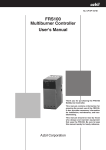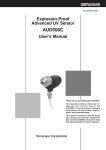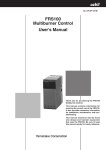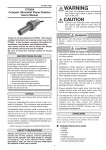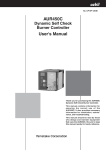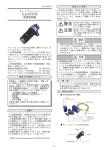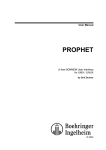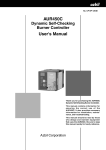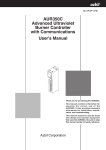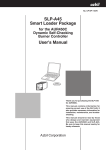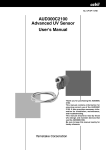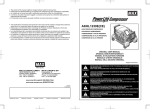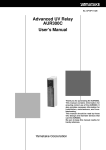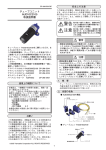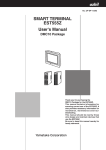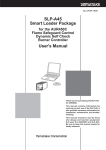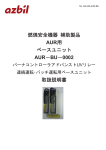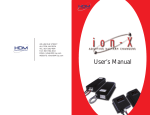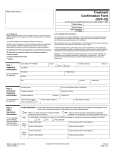Download AUR300C User`s Manual
Transcript
No. CP-SP-1142E AUR300C Advanced Ultraviolet Burner Controller User's Manual Thank you for purchasing the AUR300C. This manual contains information for ensuring correct use of the AUR300C. It also provides necessary information for installation, maintenance, and troubleshooting. This manual should be read by those who design and maintain devices that use the AUR300C. Be sure to keep this manual nearby for handy reference. NOTICE Be sure that the user receives this manual before the product is used. Copying or duplicating this user’s manual in part or in whole is forbidden. The information and specifications in this manual are subject to change without notice. Considerable effort has been made to ensure that this manual is free from inaccuracies and omissions. If you should find an error or omission, please contact the azbil Group. In no event is Azbil Corporation liable to anyone for any indirect, special or consequential damages as a result of using this product. © 2002-2012 Azbil Corporation All Rights Reserved. SAFETY PRECAUTIONS ■ About Icons The safety precautions described in this manual are indicated by various icons. Please be sure you read and understand the icons and their meanings described below before reading the rest of the manual. Safety precautions are intended to ensure the safe and correct use of this product, to prevent injury to the operator and others, and to prevent damage to property. Be sure to observe these safety precautions. WARNING Warnings are indicated when mishandling this product might result in death or serious injury. CAUTION Cautions are indicated when mishandling this product might result in minor injury to the user, or only physical damage to the product. ■ Examples Use caution when handling the product. The indicated action is prohibited. Be sure to follow the indicated instructions. i WARNING This unit is not equipped with the prepurge timer and sequence functions necessary for burner ignition. The overall equipment must be designed carefully, taking the timer and sequence functions into consideration. Do not allow the pilot or main burner "Safety time" (ignition trial time) to exceed the specifications of the burner or equipment manufacturer. If they do, fuel may accumulate in the combustion chamber and form an explosive air-fuel mixture, resulting in a serious explosion hazard. Before wiring, mounting, or removing this device, be sure to turn the power off. Wiring with the power on can result in an electric shock. Do not connect a solenoid valve to the high voltage side of the circuit. If a ground fault occurs, the ground fault current may energize and open the solenoid valve. This device will not be able to prevent the valve from opening and fuel from flowing out. Never touch any terminal of this unit during trial-run adjustment. Doing so may cause an electric shock. Make sure that the flame detector does not detect sources of ultraviolet rays other than the burner flame. If it senses the wrong source of ultraviolet rays, even if the burner goes out, a flame will be reported, and fuel will continue to be discharged, causing a very serious explosion hazard. Carry out the pilot turndown test carefully. If the flame detector is set so that it detects a pilot flame that is too small to ignite the main burner, this device will not be able to detect a flame failure in the main burner. In that case, fuel will continue to be supplied, causing a serious explosion hazard. Before the pilot turndown test or ignition spark response test, make sure that all manual fuel valves are closed. If the pilot turndown test must be carried out repeatedly, completely shut down all equipment each time the test is finished, and completely discharge unburned gas or fuel that has accumulated in the ducts and combustion chamber. Failure to discharge unburned gas or fuel may result in an explosion. When the pilot turndown test is complete, turn OFF the power switch to shut down the power. Restore all test jumpers and limit interlock/regulator settings to their previous states. If operation begins without the above steps, damage to the equipment, gas leak or explosion may result. Do not start regular operation of the equipment without first completing the trial-run adjustments for this device, as well as the tests specified by the equipment manufacturer. ii WARNING Never touch any terminal of this unit while the power is being supplied. Doing so may cause an electric shock. Even after the power to this device is turned off, terminal F continues to hold an electrical charge. To avoid electrical shock, do not touch terminal F. CAUTION This product does not have a built-in fuse for the load. Be sure to install a fuse or circuit breaker externally to guard against a short circuit of the load due to miswiring, faulty insulation, etc. Also, if a short circuit of the load does occur, this product should faulty insulation, etc. Also, if a short circuit of the load does occur, this product should be replaced, because there is an increased probability of contact failure. This unit is specially designed for intermittent burner operation (system is started and stopped once or more every 24 hrs.) and 24-hour continuous burner operation (combustion continues for 24 hrs. or longer). A flame detector having a self-checking function must be used in combination with this unit. Do not install where exposed to any of the following: • Certain chemicals or corrosive gases (ammonia, sulfur, chlorine, ethylene compounds, acid, etc.). • Splashing water or excessive humidity. • High temperatures. • Prolonged vibration. Carry out the wiring work in conformity with the standards specified in this document. Make sure the load connected to each terminal does not exceed the rating indicated in the specifications. If timers and auxiliary relays are needed for additional functions, select ones with high reliability, and be sure to design the circuit correctly. Installation, wiring, inspection, adjustment, etc. should be carried out by a trained and experienced technician who has knowledge and technical skills related to combustion equipment and flame safeguard control devices. When installing and wiring, be sure to follow the instructions in this manual and in the user's manual for the combustion equipment. The ignition transformer ground lead should be connected directly to the burner body or to a metallic part electrically connected to the burner body. iii CAUTION Run the high-voltage ignition transformer cable separately and keep it at least 10 cm away from this device. Keep power lines and ignition transformer high-voltage cables separate from the flame detector wires. Make sure that ignition transformer high-voltage cables are properly connected to prevent faulty contact. Faulty contact might generate highfrequency radio waves which can cause malfunction. Always connect the power supply last. Otherwise, touching a terminal accidentally could result in electric shock or damage. In keeping with technical standards for electrical equipment, the burner body must have an earth ground connection with a resistance of less than 100 Ω. Always supply electric power at the voltage and frequency stated on the model label of this device. After the wiring is complete, be sure to check that it is correct. Incorrect wiring may cause damage or faulty operation. Only an experienced technician who has knowledge and technical skills related to combustion equipment and combustion safety should carry out the pilot turndown test. This product is equipped with functions that are extremely important for the safe operation of combustion equipment. Carefully follow the instructions for its use that are given in this user's manual. If the safety shutoff has been activated, check all of the items on the checklists in chapter 3, TRIAL-RUN ADJUSTMENT before restarting the equipment. When doing a maintenance inspection of the burner, be sure to do the pilot turndown test. Inspection must be done at least once a year. When cleaning the burner, clean the flame detector as well. iv The Role of This Manual In all, two manuals have been prepared for the AUR300C and AUD300C. Read the manual according to your specific requirements. The following lists all the manuals that accompany the AUR300C and AUD300C and gives a brief outline of the manual: If you do not have the required manual, contact the azbil Group or your dealer. AUR300C Advanced Ultraviolet Burner Controller Manual No.CP-SP-1142E This manual Personnel in charge of design, mounting, operation, and maintenance of combustion equipment using the AUR300C should read this manual. The manual describes the mounting, wiring, trial-run adjustment, and maintenance and inspection of the AUR300C. AUD300C1000 Advanced Ultraviolet Flame Detector Manual No.CP-SP-1141E The manual describes mounting, wiring, maintenance, inspection, and troubleshooting of the AUD300C when it is used in combustion equipment. AUD500C11000 series Explosion-Proof Advanced Ultraviolet Flame Detector Manual No.CP-SP-1328E It describes the mounting, wiring, maintenance, inspection, and troubleshooting of the AUD500C when it is used in combustion equipment. C P-U User's 3JE M-546 l Manua G WARNIN N CAUTIO WARN CAU TI C P-U User's 3JE M-546 l Manua ING ON G WARNIN N CAUTIO WARN CAU TI ING ON FSP300C Flame Simulator Manual No.CP-SP-1209E Personnel in charge of the operational check of the AUD300C/500C or the AUR300C/350C/450C using the FSP300C should read this manual. It describes mounting, handling, and precautions for use of the FSP300. FSP136A Analog Flame Meter Manual No.CP-SP-1212E Personnel in charge of measuring the voltage of the AUR300C/350C/450C using the FSP136A should read this manual. The manual includes precautions for use of the FSP136A. v Conventions Used in This Manual The following conventions are used in this manual: Handling Precaution : Handling Precautions indicate items that the user should pay attention to when handling the AUR300C. (1), (2), (3) : The numbers with the parenthesis indicate steps in a sequence or indicate corresponding parts in an explanation. >> : Indicates the result of operation or the state of the device after operation. vi Contents SAFETY PRECAUTIONS The Role of This Manual Conventions Used in This Manual Chapter 1. OVERVIEW ■ ■ ■ ■ ■ Chapter 2. Overview • • • • • • • • • • • • • • • • • • • • • • • • • • • • • • • • • • • • • • • • • • • • • • • • • • • • • • • • • • • • • • • • • 1 Features • • • • • • • • • • • • • • • • • • • • • • • • • • • • • • • • • • • • • • • • • • • • • • • • • • • • • • • • • • • • • • • • • 1 Part names • • • • • • • • • • • • • • • • • • • • • • • • • • • • • • • • • • • • • • • • • • • • • • • • • • • • • • • • • • • • • • • 2 Model No. • • • • • • • • • • • • • • • • • • • • • • • • • • • • • • • • • • • • • • • • • • • • • • • • • • • • • • • • • • • • • • • • 3 Configuration • • • • • • • • • • • • • • • • • • • • • • • • • • • • • • • • • • • • • • • • • • • • • • • • • • • • • • • • • • • • 3 MOUNTING AND WIRING 2-1 Mounting • • • • • • • • • • • • • • • • • • • • • • • • • • • • • • • • • • • • • • • • • • • • • • • • • • • • • • • • • • • • • • • • • • • • 4 2-2 Wiring• • • • • • • • • • • • • • • • • • • • • • • • • • • • • • • • • • • • • • • • • • • • • • • • • • • • • • • • • • • • • • • • • • • • • • • • 6 ■ Wiring diagram• • • • • • • • • • • • • • • • • • • • • • • • • • • • • • • • • • • • • • • • • • • • • • • • • • • • • • • • • • • 7 ■ Wiring to AUD300C • • • • • • • • • • • • • • • • • • • • • • • • • • • • • • • • • • • • • • • • • • • • • • • • • • • • • • 8 ■ Wiring to solenoid valve • • • • • • • • • • • • • • • • • • • • • • • • • • • • • • • • • • • • • • • • • • • • • • • • • 9 ■ Cautions for continuous measurement of flame voltage • • • • • • • • • • • • • • • • • 9 2-3 Operational Description • • • • • • • • • • • • • • • • • • • • • • • • • • • • • • • • • • • • • • • • • • • • • • • • • • • • 10 Chapter 3. TRIAL-RUN ADJUSTMENT ■ ■ ■ ■ ■ ■ Chapter 4. Outline of adjustment • • • • • • • • • • • • • • • • • • • • • • • • • • • • • • • • • • • • • • • • • • • • • • • • • • • 12 Pre-operational inspection• • • • • • • • • • • • • • • • • • • • • • • • • • • • • • • • • • • • • • • • • • • • • • 13 Measurement of flame signal (flame voltage) • • • • • • • • • • • • • • • • • • • • • • • • • • • 13 Pilot turndown test • • • • • • • • • • • • • • • • • • • • • • • • • • • • • • • • • • • • • • • • • • • • • • • • • • • • • 14 Ignition spark response test • • • • • • • • • • • • • • • • • • • • • • • • • • • • • • • • • • • • • • • • • • • • 16 Safety shut-off test • • • • • • • • • • • • • • • • • • • • • • • • • • • • • • • • • • • • • • • • • • • • • • • • • • • • • 17 MAINTENANCE AND INSPECTION ■ Frequency of maintenance and inspection Chapter 5. • • • • • • • • • • • • • • • • • • • • • • • • • • • • • 18 SPECIFICATION ■ Specification • • • • • • • • • • • • • • • • • • • • • • • • • • • • • • • • • • • • • • • • • • • • • • • • • • • • • • • • • • • • 20 ■ Dimensions • • • • • • • • • • • • • • • • • • • • • • • • • • • • • • • • • • • • • • • • • • • • • • • • • • • • • • • • • • • • • 21 vii Chapter 1. OVERVIEW ■ Overview This Advanced Ultraviolet Burner Controller AUR300C (hereafter referred to as AUR300C) is a burner controller with a dynamic self-checking function and is used in combination with the Advanced Ultraviolet Flame Detector AUD300C (hereafter referred to as AUD300C). As the shutter of the AUD300C is driven, the AUR300C drives the flame relay while checking the AUD300C or AUR300C for faulty part. If a fault occurs in the flame detection circuit of the AUD300C or AUR300C, the AUR300C turns OFF the relay firmly to ensure the operational safety. ■ Features ● The AUR300C can monitor each burner. ● The dynamic self-checking function continuously performs the self-checking of the flame detection circuits of the AUD300C and AUR300C to ensure the operational safety. • If a fault occurs in the circuit of the AUD300C or AUR300C before starting the operation, the main valve is not opened to ensure the safety even though the start operation is performed. • If a fault occurs in the flame amplifier of the AUD300C or AUR300C during combustion, the main valve and pilot valve are shut-off. ● If a fault is found during start-up operation, the check relay is not turned ON and the output (flame output) to the main valve is not performed. ● The operation status can be checked using various LED indicators (POWER, SHUTTER, START CHECK, and FLAME). ● A flame signal output (0 to 5 Vdc) is provided as a standard function. This is useful for burner adjustment and flame status control. 1 Chapter 1. OVERVIEW ■ Part names Details of indicators 14 14 13 13 12 12 SHUTTER (G) UV SENSOR (F) 11 − 10 0-5V + 9 K3 K1 K2 11 10 Name POWER (Green) SHUTTER (Green) START CHECK (Green) FLAME (Green) Color Green Green Green Green Description Lights up when the power is turned ON. Lights up when the shutter is closed. Synchronized with the K1 relay (start check). Synchronized with the K2 relay (flame detection). ! " # $ !"$%&& '&& !"$%&& '&& 9 8 8 7 7 6 6 5 5 4 4 3 3 2 2 1 1 ● Terminal pin assignments Terminal No. 2 Description 14 AUD300C/500C Shutter (white) 13 AUD300C/500C Shutter (white) 12 AUD300C/500C G-terminal (yellow) 11 AUD300C/500C F-terminal (blue) 10 Flame voltage output (–) 9 Flame voltage output (+) 8 K3 relay output 7 K3 relay output 6 Flame output (K1, K2) 5 Contact output common 4 K2 relay NC (Flame relay NC) 3 Start input 2 Power supply (R) high voltage side 1 Power supply (S) ground side Electrical rating 24 Vdc 150 mA *3 *1: Functions in the same manner as the — 0 to 5 Vdc *2 3 A 250 V (cos φ =1)*1 5 A 250 V (cos φ =1) — 5 A 250 V (cos φ =1) — 100/200 Vac 50/60 Hz K2 relay. (However, since the start check is not performed, this is not used for the combustion control, but used for the combustion monitor.) *2: Always use a measuring instrument having an input impedance of 100 kΩ or more. Additionally, when connecting any measuring instrument to this terminal, use an IV lead wire with a cross sectional area of 0.75 mm2 or more and a length of 10 m or less. *3: The shutter has no polarities. Chapter 1. OVERVIEW ■ Model selection table Basic No. Function Flame response AUR300C 1 2 3 Power supply Additional processing 1 2 00 D0 T0 DT Description Advanced Ultraviolet Burner Controller Fixed Nominal 1.5 s (max. 2 s) Nominal 3 s (max. 4 s) 100 Vac 200 Vac No additional processing Inspection certificate provided Tropicalization treatment applied Tropicalization treatment applied and inspection certification provided ■ Configuration ● Combined flame detector Description Advanced Ultraviolet Flame Detector Explosion-proof Advanced Ultraviolet Flame Detector Model No. AUD300C1000 AUD500C11000 ● Optional parts Description Flame simulator Analog flame meter Surge absorber Model No. FSP300C100 FSP136A100 83968019-001 3 Chapter 2. 2 - 1 MOUNTING AND WIRING Mounting CAUTION Do not install where exposed to any of the following: • Certain chemicals or corrosive gases (ammonia, sulfur, chlorine, ethylene compounds, acid, etc.). • Splashing water or excessive humidity. • High temperatures. • Prolonged vibration. When installing and wiring, be sure to follow the instructions in this manual and in the user's manual for the combustion equipment. ● Mounting posture Mount this unit on a wall. When mounting this unit vertically, it is possible to tightly mount the unit. ● Mounting procedures (1) To allow easy removal, heat radiation, wiring, and maintenance work, keep a work space that is 20 mm or more in the vertical direction and 10 mm or more in the horizontal direction as shown in the Fig. below. Vertical mounting (It is possible to tightly mount the unit.) − + − + − + Horizontal mounting 4 + − Chapter 2. MOUNTING AND WIRING (2) According to the mounting dimension drawing, make mounting holes in the panel. Vertical mounting Horizontal mounting Mounting dimension drawing (3) Secure this unit to the mounting holes (four locations) with M4 screws. Handling Precautions • The paint of the lower right mounting hole of this unit is peeled off to make the electric continuity active, and then this part is used as the chassis ground connection part. Secure this part with the toothed lock washer to perform the electric connection firmly. • When mounting this unit horizontally, it is not possible to tightly mount the unit. 5 Chapter 2. MOUNTING AND WIRING 2 - 2 Wiring WARNING Before wiring, mounting, or removing this device, be sure to turn the power off. Wiring with the power on can result in an electric shock. The terminal 11 (F) is electrically alive within 1 min. after the power to this unit has been turned OFF. Never touch the terminal 11 (F) immediately after the power has been turned OFF. Doing so may cause an electric shock. The combustion lamp output can be operated in the same way as K2. However, as the start check is not made, use it for monitoring purpose without using it for combustion control. CAUTION This product does not have a built-in fuse for the load. Be sure to install a fuse or circuit breaker externally to guard against a short circuit of the load due to miswiring, faulty insulation, etc. Also, if a short circuit of the load does occur, this product should faulty insulation, etc. Also, if a short circuit of the load does occur, this product should be replaced, because there is an increased probability of contact failure. Cary out the wiring work in conformity with the standards specified in this document. Make sure the load connected to each terminal does not exceed the rating indicated in the specifications. If timers and auxiliary relays are needed for additional functions, select ones with high reliability, and be sure to design the circuit correctly. When installing and wiring, be sure to follow the instructions in this manual and in the user's manual for the combustion equipment. The ignition transformer ground lead should be connected directly to the burner body or to a metallic part electrically connected to the burner body. Run the high-voltage ignition transformer cable separately and keep it at least 10 cm away from this device. Keep power lines and ignition transformer high-voltage cables separate from the flame detector wires. Make sure that ignition transformer high-voltage cables are properly connected to prevent faulty contact. Faulty contact might generate highfrequency radio waves which can cause malfunction. Always connect the power supply last. Otherwise, touching a terminal accidentally could result in electric shock or damage. In keeping with technical standards for electrical equipment, the burner body must have an earth ground connection with a resistance of less than 100 Ω. Be sure to check the condition of the insulation on the wiring. An insulation failure might cause a ground fault or electric shock. Always supply electric power at the voltage and frequency stated on the model label of this device. After the wiring is complete, be sure to check that it is correct. Incorrect wiring may cause damage or faulty operation. 6 Chapter 2. MOUNTING AND WIRING ■ Wiring diagram ● Monitoring of burner flame ● Manual ignition (Intermittent pilot) 4 !#3.! #* !* ! !* !##! 7 ! 8 .& - $ - - - >! .+!# < - ') '() '") 4 - 5 6 - 8 - - - < - ') "$ ') =? =!& .** , ') = ! # !* .& =? =!& .** , 1 !#3.! #* !* ! 2 - 5 6 " # !* 0 " # ! !* 1 % !& / $. .# ! 2 '") " # ! !* $. .# 0 '() " # #* +, / "$ % !& ! " # ! ! " # ! " # #* +, 9 ; < ; " # ! ; !#3.! #* Handling Precautions • If the high voltage side (H) of the power supply is distinguished from the grounding side (G), the high electrical potential side (H) is connected to the terminal 2 (R) and the grounding side (G) to the terminal 1 (S). • When necessary, an overload prevention device is used for the power supply. ● Wiring to surge absorber When using the surge absorber model 83968019-001 (optional unit) as protective measures against lightning, connect it as shown below. AUR300C Voltage side (H) ∼ Power supply Grounding side (G) Surge absorber 83968019-001 AUR300C Voltage side (H) 2 (R) 1 (S) ∼ Power supply Grounding side (G) 2 (R) 1 (S) Surge absorber between lines Flat terminal, FS4.8-series terminal side Mounting bracket side (Grounding side) 7 Chapter 2. MOUNTING AND WIRING Handling Precautions • For wiring of the power supply, use an electric cable JIS C 3306 having an cross sectional area of 0.75 mm2 or more (wire diameter: φ 0.18, number of strand wires: 30). • Connect the flat connector FS4.8-series (AMP's 187-series receptacle or equivalent) to one end of the electric cable and make the wiring as short as possible. • The grounding side of the metallic bracket for mounting of the surge absorber is crimped internally to make the electric continuity active. Mount this bracket on a metallic part, such as burner chassis to connect the grounding line. ■ Wiring to AUD300C Make the wiring to the AUD300C as shown below. Advanced Ultraviolet Flame Detector AUD300C Advanced Ultraviolet Burner Controller AUR300C White White Yellow Blue 14 13 12 (G) 11 (F) Handling Precautions • The signal lines of the AUD300C (blue and yellow) have specific polarities. Connect the blue line to the terminal 11 (F) of the AUR300C and the yellow line to the terminal 12 (G). If the signal lines are connected reversely, this may cause the tube unit to break or malfunction. • 8 To extend the wiring, use a 600V-vinyl insulated IV cable having a cross sectional area of 2 mm2 and a length of 200 m or less. Chapter 2. MOUNTING AND WIRING ■ Wiring to solenoid valve WARNING Do not connect a solenoid valve to the high voltage side of the circuit. If a ground fault occurs, the ground fault current may energize and open the solenoid valve. This device will not be able to prevent the valve from opening and fuel from flowing out. ● Correct connection High voltage side (H) 100 or 200 V Grounding side (G) N AUR300C L (Ground fault) Valve (Close) Combustion equipment Burner Power supply Fuel When the valve wiring is connected correctly as shown in the Fig., the ground fault current does not flow through the solenoid valve even though a ground fault occurs due to faulty insulation of the high electrical potential side. Therefore, the valve is not opened and the fuel does not flow out. ● Incorrect connection %&'(! !"# $" When the valve wiring is connected to the high electrical potential side, the ground fault current flows through the solenoid valve if a ground fault occurs as shown in the Fig. Therefore, the valve is opened regardless of this unit and the fuel flows out. ■ Cautions for continuous measurement of flame voltage • Connect a measuring instrument having an input impedance of 100 kΩ or more and a pen recorder having an input impedance of 1 MΩ to this unit. • Always use an IV cable with a cross sectional area of 0.75 mm2 or more for signal lines. The wiring length must be 10 m or less. 9 Chapter 2. MOUNTING AND WIRING Operational Description - ') ') - - - - < .& 4 2 - 3 = ! # !* .& >! .+!# $ ! " # ! !#9.! #* $. .# 5 7 8 7 " # ! 7 !#9.! #* . !* & .,!: & ; '"! !#9.! #!!) 0 - ! 1 '") '() " # ! !* / % !& " # #* +, (Intermittent pilot) "$ Manual ignition method =? 2 - 3 Power supply switch (H) • Operation is changed from normal operation to flame shut-off operation Power switch ON Start switch ON Flame detection Start switch OFF Power switch Start switch Ignition transformer Pilot valve Main valve Combustion lamp POWER LED SHUTTER LED START CHECK LED (K1) FLAME LED (K2) FLAME • False flame exists before ignition. Power switch ON False flame Start switch ON Power switch Start switch Ignition transformer Pilot valve Main valve Combustion lamp POWER LED SHUTTER LED START CHECK LED (K1) FLAME LED (K2) FLAME 10 Start switch OFF Flame failure Flame response (G) Chapter 2. MOUNTING AND WIRING • Flame signal exists when the shutter is closed. Power switch ON Start switch ON Start switch OFF Power switch Start switch Ignition transformer Pilot valve Main valve Combustion lamp POWER LED SHUTTER LED START CHECK LED (K1) FLAME LED (K2) FLAME Operation Operation of this unit Power ON Limit ON • Voltage is applied to the terminal 1 (S) and 2 (R). (Voltage is applied to the Ultraviolet Burner Controller.) • As the electric power is applied to the terminal 3, the K1 relay is turned ON through the flame relay contact K2-1 (close: false flame check) • As the pilot flame is detected, the flame relay (K2) is turned ON. The output of the pilot valve is kept at the same time when the K1 relay is kept turned ON as the contacts K1-1 and K1-2 are closed. • As K2-2 and K1-3 are closed, the main valve enters the stand-by mode. • As K3-1 is closed, the combustion lamp lights up. • As the electric power is applied from the terminal 3 to terminals 5 and 6 to operate the main valve. • All relays are turned OFF. Start SW ON Start SW OFF Stop operation Stop SW OFF Flame shut-off during operation • All relays are turned OFF. POWER LED ● SHUTTER START FLAME LED CHECK LED LED ○ ○ ○ ● ○ ● ○ ● ◎ ● ● ● ◎ ● ● ● ◎ ● ● ● ◎ ● ● ○ ○ ○ ○ ● ○ ○ ○ ●: Lit, ○: Off, ◎: Flash 11 Chapter 3. TRIAL-RUN ADJUSTMENT WARNING Do not allow the pilot or main burner "Safety time" (ignition trial time) to exceed the specifications of the burner or equipment manufacturer. If they do, fuel may accumulate in the combustion chamber and form an explosive air-fuel mixture, resulting in a serious explosion hazard. Before wiring, mounting, or removing this device, be sure to turn the power off. Wiring with the power on can result in an electric shock. Never touch any terminal of this unit during trial-run adjustment. Doing so may cause an electric shock. Before the pilot turndown test or ignition spark response test, make sure that all manual fuel valves are closed. Do not start regular operation of the equipment without first completing the trial-run adjustments for this device, as well as the tests specified by the equipment manufacturer. Even after the power to this device is turned off, terminal F continues to hold an electrical charge. To avoid electrical shock, do not touch terminal F. ■ Outline of adjustment The following shows the test adjustment items described in this chapter: • Measurement of flame voltage • Pilot turndown test • Ignition spark response test • Safety shut-off test Handling Precautions After the above items have been adjusted, check again that each adjustment item is satisfied. It is absolutely necessary to satisfy all adjustment items at the final mounting position of the flame detector. ● Tools and parts needed • Multi-meter • Analog Flame Meter Input impedance 100 kΩ or more AC range 0 to 300 V FSP136A • Jumper cable with alligator clip, 2 cables 12 Chapter 3. TRIAL-RUN ADJUSTMENT ■ Pre-operational inspection (1) Inspect all wiring parts. (2) Check that the unit is mounted in a place where the ambient temperature is within its allowable range. (3) Check that the AUD300C/500C is mounted correctly. In particular, the blue lead wire (to terminal 11) and yellow lead wire (to terminal 12) of the AUD300C/500C are connected correctly. For details, refer; AUD300C user's manual, No. CP-SP-1141E AUD500C user's manual, No. CP-SP-1328E (4) Check that the valves and cocks of each fuel system are closed and that the inside of the fuel chamber is exhausted sufficiently. (5) After above items (1) to (4) have been checked, supply the power and start the trial-run adjustment. ■ Measurement of flame signal (flame voltage) Start the equipment and measure the voltage under several conditions, such as start-up operation or normal operation. (1) Set the FSP136A to the 7.5 Vdc range. (2) Connect the + (positive) probe of the FSP136A to terminal 9 and the (negative) probe to terminal 10. (3) Check that the voltage is stable and 2.0 Vdc or more. Recommended flame voltage: Stable 2.0 Vdc or more. (4) If the flame voltage fluctuates largely, check the mounting position of the AUD300C/500C and wiring status. Handling Precautions Even during normal operation, the flame voltage is synchronized with the shutter operation of the AUD300C/500C and fluctuates in a range of 0.1 to 0.3 V. 13 Chapter 3. TRIAL-RUN ADJUSTMENT ■ Pilot turndown test This test is intended to check that the flame is carried over to the main burner correctly when the AUD300C/500C detects the pilot flame if the gas pressure and air pressure are changed to their worst conditions. WARNING Carry out the pilot turndown test carefully. If the flame detector is set so that it detects a pilot flame that is too small to ignite the main burner, this device will not be able to detect a flame failure in the main burner. In that case, fuel will continue to be supplied, causing a serious explosion hazard. If the pilot turndown test must be carried out repeatedly, completely shut down all equipment each time the test is finished, and completely discharge unburned gas or fuel that has accumulated in the ducts and combustion chamber. Failure to discharge unburned gas or fuel may result in an explosion. When the pilot turndown test is complete, turn OFF the power switch to shut down the power. Restore all test jumpers and limit interlock/regulator settings to their previous states. If operation begins without the above steps, damage to the equipment, gas leak or explosion may result. CAUTION Only an experienced technician who has knowledge and technical skills related to combustion equipment and combustion safety should carry out the pilot turndown test. Handling Precautions If the limit of the fuel pressure (if used) is opened, make it turned ON with a jumper cable during this test. To carry out the pilot turndown test, follow the steps below. ● Preparations before starting test (1) Turn OFF the POWER switch. (2) Close the manual valves of the pilot passage and main passage to stop the gas. (3) Open the manual valve of the pilot passage. ● Check a gas pressure level, at which the AUD300C/500C cannot detect the pilot flame. (4) Turn ON the POWER switch and START switch. >> The ignition operation is then started, the pilot valve is opened, and the ignition transformer is operated. The flame relay is turned ON and combustion lamp lights up. 14 Chapter 3. TRIAL-RUN ADJUSTMENT (5) Slowly close the manual valve of the pilot passage. The pilot flame becomes small gradually. Gradually throttle the valve until the AUD300C/500C cannot detect the flame. (6) Record the gas pressure immediately before the flame relay is turned OFF and the combustion lamp goes off. ● Check that the main burner can be ignited with the minimum pilot flame. (7) Press the START switch again. (8) Slowly open the manual valve of the pilot passage to adjust the pressure to a level immediately before the combustion lamp goes off. At this time, check that the flame relay is turned ON and the combustion lamp lights up. (9) Release the IGNITION switch. (10) Check that the main burner is ignited smoothly within 1 sec. after the manual valve of the main passage has been opened. (11) Change the gas pressure level between the minimum and maximum levels and ignite the main burner five or six times. At this time, check that the main burner is ignited smoothly every time. ● Main burner is not ignited with the minimum pilot flame. (12) Adjust the mounting position of the AUD300C/500C and the incoming light amount so that the AUD300C/500C cannot detect the ignition of the main burner. There are two kinds of adjustment procedures as shown below. • Keep the monitoring wire of the monitoring pipe slightly away from the pilot flame. • Throttle the monitoring pipe to decrease the incoming light amount from the pilot flame. (13) Slowly open the manual valve of the pilot passage to make the pilot flame larger than the previous flame. ● After the adjustment has been completed, check again that the main burner can be ignited with the minimum flame. (14) Perform the steps stated in "Check that the main burner can be ignited with the minimum pilot flame" again. ● Measures to be taken after completion of the test (15) After the test has been completed, return the manual valve of the main passage to its fully opened position. (16) Check that the flame voltage is proper. (17) If any limit is connected with jumper cables, disconnect them to return the limit to its previous state. 15 Chapter 3. TRIAL-RUN ADJUSTMENT ■ Ignition spark response test WARNING Make sure that the flame detector does not detect sources of ultraviolet rays other than the burner flame. If it senses the wrong source of ultraviolet rays, even if the burner goes out, a flame will be reported, and fuel will continue to be discharged, causing a vary serious explosion hazard. (1) Close the manual fuel valves of the pilot and main burners. (2) Start the operation and measure the flame voltage in the pilot ignition sequence to check whether or not the flame voltage is influenced. (3) If the "FLAME" LED is lit, make the adjustment using the following procedures while referring to the instruction manual for the equipment: • Move the position of the AUD300C/500C or ignition spark rod so that they do not affect adversely. • Put a shield plate in the optical path of the AUD300C/500C so that the effect of the spark is a flame signal value of 0.4 Vdc or less. Handling Precautions Do not use this unit to detect ultraviolet rays other that those of the flame. The following shows various ultraviolet ray sources other than flame that may activate the AUD300C/500C: Examples: Ultraviolet ray source Gamma-ray and X-ray source 16 Scorching furnace wall with a temperature of 1371 ˚C or more (within 50 cm of furnace wall) Spark Ignition transformer and welding arc Gas laser Sunlamp Disinfecting lamp, ultraviolet radiation lamp, fluorescent lamp Strong flash light (toward Ultraviolet Flame Detector) X-ray diffraction and gamma-ray analysis measurement equipment Electron microscope X-ray camera High voltage vacuum switch High voltage capacitor Radioisotope Other sources producing ultraviolet rays, gamma-rays, and X-rays Chapter 3. TRIAL-RUN ADJUSTMENT ■ Safety shut-off test After all operational adjustments have been completed, carry out the safety shutoff test. ● Pilot ignition failure (Ignition failure) (1) Close the pilot and main manual fuel valves. (2) Press the START switch. >> The operation is then started. (3) Normally, as the pilot burner is ignited, the pilot valve is opened. Check that the "FLAME" LED does not light up and the main valve is not opened if the flame fails. ● Flame failure during normal combustion (1) Open the pilot and main manual fuel valves. (2) Press the START switch to start the operation. (3) When the sequence advances correctly and it enters the normal combustion (main valve is opened), close the pilot and main manual fuel valves to put off the burner flame. At this time, check that the flame failure is detected and the safety shut-off is activated correctly. 17 Chapter 4. MAINTENANCE AND INSPECTION WARNING Before wiring, mounting, or removing this device, be sure to turn the power off. Wiring with the power on can result in an electric shock. Even after the power to this device is turned off, terminal F continues to hold an electrical charge. To avoid electrical shock, do not touch terminal F. CAUTION Installation, wiring, inspection, adjustment, etc. should be carried out by a trained and experienced technician who has knowledge and technical skills related to combustion equipment and flame safeguard control devices. If the safety shutoff has been activated, check all of the items on the checklists in chapter 3, TRIAL-RUN ADJUSTMENT before restarting the equipment. When doing a maintenance inspection of the burner, be sure to do the pilot turndown test. Inspection must be done at least once a year. When cleaning the burner, clean the flame detector as well. ■ Frequency of maintenance and inspection Determine an appropriate frequency of the maintenance and inspection work by considering the equipment type, ambient conditions (dust or ambient temperature) of the mounting place, and damage or influence if the burner is shut-off for some reason during operation of the equipment. Inspection contents Safety shut-off test (For details, refer to Chapter 3, TRIAL-RUN ADJUSTMENT.) Contamination of monitoring window and monitoring pipe of AUD300C/500C Measurement of flame voltage Pilot turndown test Inspection frequency Once a month or more Once a month or more Once a month or more Once a year or more Handling Precautions • If the burner shut-off operation may cause a serious accident, perform the inspection more frequently. • If the burner manufacturer provides specific instructions about the maintenance and inspection, always strictly observe them. 18 Chapter 4. MAINTENANCE AND INSPECTION ● Fault inspection flowchart !" # $"" / 0 # / 0 ,1 # ,1 / 9 · · · %&'% &( )) · 9 · · %*+% &( )) 0 ) , 1 , ) ) ) ) / 0 ) / 0 +233/ 0 +(2334533/ )6# ) , ,4 ) , #" · 0 ) / · 0 +233/ · 9 , # 9 %'-+% # %&'% &( 9 ) 9 ,# 2"65" # !" # · · · · 0 ) 7 ,7 # / 0 ) / 0 +(2334533/ · · · 9 % *8% &( , # 9 0 +233/ 9 0 , 1 / , # " 0 / 0 ,6)) / · 0 ) 7 ,7 # / · 0 +233/ · 0 / 19 Chapter 5. SPECIFICATION ■ Specification Item Model Flame failure response time Flame voltage range (at rated voltage, room temp, and humidity) Recommended flame voltage Compatible flame detector Rated power supply voltage Allowable voltage range Power consumption Contact rating Dielectric strength Insulation resistance Induced thunderbolt surge Service life Ambient temperature Storage temperature Ambient humidity Vibration resistance Terminal screw tightening torque Mounting posture Color Mass 20 AUR300C12_ _ _ Nominal 1.5 s, (Max. 2 s) at 3 V flame voltage Flame-out detection: 0.0 to 0.6 Vdc Flame establishment: 1.5 to 4.0 Vdc Description AUR300C13_ _ _ Nominal 3 s, (Max. 4 s) at 3 V flame voltage Stable 2.0 Vdc or more AUD300C, AUD500C 100 Vac or 200 Vac at 50/60 Hz 85 to 110 % of rated power supply voltage 10 W max. (with AUD300C/500C) Flame output (K1, K2) : 5 A 250 V (cos φ = 1) Flame output (K2) : 5 A 250 V (cos φ = 1) Combustion Lamp output (K3) : 3 A 250 V (cos φ = 1) 1500 Vac 50/60 Hz 1 min or 1800 Vac 50/60 Hz 1 s Application points: Between ground and primary terminals 1 to 8 units (except 9 to 14) 100 MΩ min. by 500 Vdc megger Measurement points: Between ground and primary terminals 1 to 8 units (except 9 to 14) 10 kV, 1.2/50 µs (JEC-187: 75 Ω min. surge impedance) The surge absorber listed hereunder must be connected between the power supply terminal (No.1 terminal) and the ground. • Recommended surge absorber: Part No. 83968019-001 7 years or 100,000 cycles (operation cycles of each relay) -20 to +60 °C -20 to +70 °C 90 % RH at 40 °C max. 4.9 m/s2 max., 10 to 55 Hz for 2 h each in X, Y and Z directions 1.4 N·m max. Wall mounting (vertical or horizontal mounting) White Approx. 1.2 kg Chapter 5. SPECIFICATION ■ Dimensions Unit: mm 60 37 94.1 5 4-R 14 14 13 13 12 12 UV SENSOR (F) 11 11 SHUTTER (G) − 10 0-5 V + 9 K3 238 249 261 Free terminal screw M4 10 9 8 8 7 7 K1 K2 6 6 5 5 4 4 3 3 2 2 1 1 1.2 87.2 16.6 Chassis ground (commonly used as mounting screw) 21 Revision History Printed Date Manual Number Edition 02-12 04-08 CP-SP-1142E 1st Edition 2nd Edition Revised pages RESTRICTIONS ON USE changed “Duplicate pilot” changed to “Intermittent pilot” Manual name changed. Endpaper RESTRICTIONS ON USE deleted. End of a book Terms and Conditions added. i Caution icon explanations corrected ii, iii, iv, 4, 6, 12, Descriptions of warnings and cautions 14, 16, 18 standardized. v Descriptions of No. CP-SP-1141E, CP-SP-1170E, CP-SP-1181E, CP-SP-1209E, CP-SP-1210E, and CP-SP-1212E added. 2 ● Terminal pin assignments: descriptions of terminals 7 and 8 changed. 3 ■ Model No.: "UV relay" changed to "Ultraviolet Burner Controller" ■ Configuration changed as follows. ● Combined flame detectors: AUD300C changed to AUD300C100, AUD300C2100 and AUD500C21010 added. ● Optional parts: FSP350A100 and FSP136A100 added and model No. 123514B (flame simulator) changed to FSP300C100. 9 100 V changed to "100 or 200 V" in the connection diagrams. 12 FSP136A100 added to ● Tools and parts needed. 13 ■ Pre-operational inspection, step (3): "AUD300C2000, CP-SP-1170E" added. ■ Measurement of flame signal, step (2): "multi meter" changed to "FSP136A." 16 "Regression analyzer" changed to "X-ray diffraction and gamma-ray analysis measurement equipment" in the list. 20 ■ Specification: Flame detector description changed from "AUD300C1000" to "AUD300C series, AUD500C series." 3 ● Combined flame detector: "Advanced UV sensor" changed to "Advanced Ultraviolet Flame Detector." Company name changed. v CP-SP-1170E and CP-SP-1210E were deleted. CP-SP-1181E was changed to CP-SP-1328E. 3 Model selection table changed. Configration table changed. 13, 16, 20 Explanation changed. 7, 10 09-06 3rd Edition 09-09 4th Edition 12-04 12-11 5th Edition 6th Edition Description Terms and Conditions We would like to express our appreciation for your purchase and use of Azbil Corporation's products. You are required to acknowledge and agree upon the following terms and conditions for your purchase of Azbil Corporation's products (field instruments, control valves, and control products), unless otherwise stated in any separate document, including, without limitation, estimation sheets, written agreements, catalogs, specifications and instruction manuals. 1. Warranty period and warranty scope 1.1 Warranty period Azbil Corporation's products shall be warranted for one (1) year from the date of your purchase of the said products or the delivery of the said products to a place designated by you. 1.2 Warranty scope In the event that Azbil Corporation's products has any failure attributable to azbil during the aforementioned warranty period, azbil shall, without charge, deliver a replacement for the said product to the place where you purchased, or repair the said product and deliver it to the aforementioned place. Notwithstanding the foregoing, any failure falling under one of the following shall not be covered under this warranty: (1) Failure caused by your improper use of Azbil Corporation's products (noncompliance with conditions, environment of use, precautions, etc. set forth in catalogs, specifications, instruction manuals, etc.); (2) Failure caused for other reasons than Azbil Corporation's products; (3) Failure caused by any modification or repair made by any person other than azbil or azbil's subcontractors; (4) Failure caused by your use of Azbil Corporation's products in a manner not conforming to the intended usage of that product; (5) Failure that the state-of-the-art at the time of Azbil Corporation's shipment did not allow us to predict; or (6) Failure that arose from any reason not attributable to Azbil Corporation, including, without limitation, acts of God, disasters, and actions taken by a third party. Please note that the term "warranty" as used herein refers to equipment-only-warranty, and Azbil Corporation shall not be liable for any damages, including direct, indirect, special, incidental or consequential damages in connection with or arising out of Azbil Corporation's products. 2. Ascertainment of suitability You are required to ascertain the suitability of Azbil Corporation's products in case of your use of the same with your machinery, equipment, etc. (hereinafter referred to as "Equipment") on your own responsibility, taking the following matters into consideration: (1) Regulations and standards or laws that your Equipment is to comply with. (2) Examples of application described in any documents provided by Azbil Corporation are for your reference purpose only, and you are required to check the functions and safety of your Equipment prior to your use. (3) Measures to be taken to secure the required level of the reliability and safety of your Equipment in your use Although Azbil Corporation is constantly making efforts to improve the quality and reliability of Azbil Corporation's products, there exists a possibility that parts and machinery may break down. You are required to provide your Equipment with fool-proof design, fail-safe design, anti-flame propagation design, safety design, or the like so that the said Equipment may satisfy the level of the reliability and safety required in your use, whereby preventing any occurrence of physical injuries, fires, significant damage, and so forth. 3. Precautions and restrictions on application Azbil Corporation's products other than those explicitly specified as applicable (e.g. azbil Limit Switch For Nuclear Energy) shall not be used in a nuclear energy controlled area (radiation controlled area). Any Azbil Corporation's products shall not be used for/with medical equipment. In addition, you are required to conduct a consultation with our sales representative and understand detail specifications, cautions for operation, and so forth by reference to catalogs, specifications, instruction manual , etc. in case that you intend to use Azbil Corporation's products for any purposes specified in (1) through (6) below. Moreover, you are required to provide your Equipment with fool-proof design, fail-safe design, anti-flame propagation design and other designs of protection/safety circuit on your own responsibility to ensure the reliability and safety, whereby preventing problems caused by failure or nonconformity. (1) For use under such conditions or in such environments as not stated in technical documents, including catalogs, specification, and instruction manuals (2) For use of specific purposes, such as: * Nuclear energy/radiation related facilities [For use outside nuclear energy controlled areas] [For use of Azbil Corporation's Limit Switch For Nuclear Energy] * Machinery or equipment for space/sea bottom * Transportation equipment [Railway, aircraft, vessels, vehicle equipment, etc.] * Antidisaster/crime-prevention equipment * Burning appliances * Electrothermal equipment * Amusement facilities (3) Supply systems such as electricity/gas/water supply systems, large-scale communication systems, and traffic/air traffic control systems requiring high reliability (4) Facilities that are to comply with regulations of governmental/public agencies or specific industries (5) Machinery or equipment that may affect human lives, human bodies or properties (6) Other machinery or equipment equivalent to those set forth in items (1) to (5) above which require high reliability and safety 4. Precautions against long-term use Use of Azbil Corporation's products, including switches, which contain electronic components, over a prolonged period may degrade insulation or increase contact-resistance and may result in heat generation or any other similar problem causing such product or switch to develop safety hazards such as smoking, ignition, and electrification. Although acceleration of the above situation varies depending on the conditions or environment of use of the products, you are required not to use any Azbil Corporation's products for a period exceeding ten (10) years unless otherwise stated in specifications or instruction manuals. 5. Recommendation for renewal Mechanical components, such as relays and switches, used for Azbil Corporation's products will reach the end of their life due to wear by repetitious open/close operations. In addition, electronic components such as electrolytic capacitors will reach the end of their life due to aged deterioration based on the conditions or environment in which such electronic components are used. Although acceleration of the above situation varies depending on the conditions or environment of use, the number of open/close operations of relays, etc. as prescribed in specifications or instruction manuals, or depending on the design margin of your machine or equipment, you are required to renew any Azbil Corporation's products every 5 to 10 years unless otherwise specified in specifications or instruction manuals. Field instruments (sensors such as pressure/flow/level sensors, regulating valves, etc.) will reach the end of their life due to aged deterioration of parts. For those parts that will reach the end of their life due to aged deterioration, recommended replacement cycles are prescribed. You are required to replace parts based on such recommended replacement cycles. 6. Other precautions Prior to your use of Azbil Corporation's products, you are required to understand and comply with specifications (e.g., conditions and environment of use), precautions, warnings/cautions/notices as set forth in the technical documents prepared for individual Azbil Corporation's products, such as catalogs, specifications, and instruction manuals to ensure the quality, reliability, and safety of those products. 7. Changes to specifications Please note that the descriptions contained in any documents provided by Azbil Corporation are subject to change without notice for improvement or for any other reason. For inquires or information on specifications as you may need to check, please contact our branch offices or sales offices, or your local sales agents. 8. Discontinuance of the supply of products/parts Please note that the production of any Azbil Corporation's products may be discontinued without notice. For repairable products, we will, in principle, undertake repairs for five (5) years after the discontinuance of those products. In some cases, however, we cannot undertake such repairs for reasons, such as the absence of repair parts. For field instruments, we may not be able to undertake parts replacement for similar reasons. Specifications are subject to change without notice. (09) 1-12-2 Kawana, Fujisawa Kanagawa 251-8522 Japan URL: http://www.azbil.com 1st edition: Dec. 2002 6th edition: Nov. 2012 (M)




































